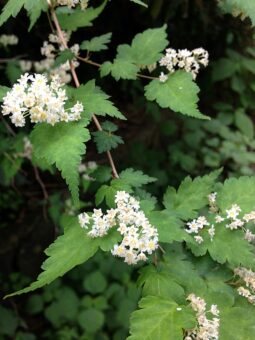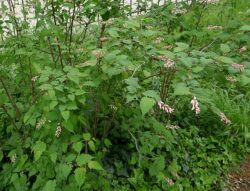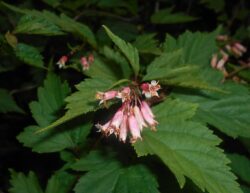In this article, we will discuss how to grow the attractive shrub of Neillia in containers. Neillia is named after the horticulturist and naturalist Patrick Neill. It used to belong to the genus Stephanandra but that has been moved to Neillia.
Neillia is a small genus of 15 to 17 species of deciduous shrubs or subshrubs that belong to the Rosaceae (the Rose) family. Neillia is found exclusively growing in Eastern and Central Asia, where they will grow freely. Stephanandra has just recently been found via phylogenetic analysis that it belongs to the Neillia family. It is speculated that Neillia and Stephanandra had hybridized with each other and so are no longer seen as separate genii, as both belong to the Neillia family.

Neillia shrubs tend not to be noted as a flowering shrubs as the white or red starry flowers tend to be small and occur in tiny clusters. They make up for the small flower clusters by producing a large number of them. The flower clusters are pleasing to look at but are not overly showy. If you think they are grown for the flowers you are mistaken as it is grown to provide attractive autumn foliage.
They look their best if grown amongst more showy flowering shrubs. They are grown for the zig-zag stems, deeply lobed and toothed, green leaves that turn a vivid yellow and red in autumn. The shrub is also thicket forming and suckers very heavily. They are either grown for the autumn leaf colours, winter stem colours or ground cover depending on what species and varieties are grown.
Find out how to grow the attractive shrub of Neillia in containers in this article.
GROWING NEILLIA IN CONTAINERS
First, choose a container that has a few drainage holes at the bottom. Not too many but enough to allow it to be free-draining and allow excess water to drain away. Choose a container that is large enough to house the plant and make it look stunning when the shrub is planted in. Make sure it is wide as possible and a half-size barrel is ideal. On top of this add a 2cm layer of gravel to allow excess water to drain away. On top of this add a moisture-retentive, multipurpose compost to act as the growing media. Add it up to 5cm below the top rim but to aid its water retention abilities I would add some water-retaining crystals/gel to make the growing media more moisture–retentive.
Dig a hole at the centre of the container slightly bigger than the root ball it came in the original pot you bought it in. drop the plant in so that the top of the root ball is at the same level as the top surface of the compost in the container. Backfill with the growing media so that no vacant area exists, using more compost if you find it necessary. Firm the plant in and water very well.
THE BEST GROWING CONDITIONS

This is one plant that thrives in partial shade as under these conditions it will require less watering. This is one plant that likes its compost to be moist at all times. You will need to water very frequently in hot, dry weather but definitely when the top surface of the compost feels dry to the touch.
As it is not a very hungry shrub I would only give an annual dressing of slow-release, general-purpose fertilizer in spring and no more. This will give enough nutrients to last throughout the growing season.
Pruning is relatively simple as all you need to do is cut down to ground one-third of all older stems after it has finished flowering.
Propagation is either via dividing clumps every 3 years in autumn or by taking semi-ripe cuttings in summer and planting them in individual pots in a cold frame.
PESTS AND DISEASES
The good news is that it seems that the plant does not suffer from pests and diseases, so will make an ideal candidate to grow in containers.
VARIETIES TO GROW
There are 4 species that can be found in the UK and these are:

Neillia incisa (Syn. Stephanandra incisa) has zig-zag stems and deeply lobed and toothed leaves. The leaves turn an attractive yellow to red in autumn before dropping off. They produce white clusters of flowers in early summer. A noted cover and low-growing plant are ‘Crisped’ with even deeper crispy leaves.
Neillia tanakae is a thicket-forming shrub with arching stems and deeply divided 3-lobed mid-green leaves that turn a deep gold in autumn. In summer green-yellow flowers are produced in clumps. The stems are orange-brown and attractive throughout winter.
Neillia affinis (Chinese Wine Bark) is an upright, deciduous shrub that grows up to 2m tall. It has arching, angular, red-brown branches with green, sharply toothed, lobed leaves that taper to a long point. The leaves turn an attractive red in winter. In late spring to early summer, short spikes of pink, small bell-shaped flowers are produced.
Neillia sinensis (Chinese Wine Bark) has lobed leaves on arching branches, where in late spring to early summer a profusion of pink flowers appear in clusters.
CONCLUSIONS
In this article, we have discovered how to grow Neillia in containers to give a profusion of flowers. They tend to be easy to grow, easy to care for, and generally pests and diseases free provided you make sure it is moist at all times and divided it every 3 years to stop it becoming congested. You also have plenty of choice as to what species you can grow, so why not grow one today?
If you have any questions or comments that you wish to make on growing Neillia in containers, please do so in the comment box below.
Happy Neillia growing.
